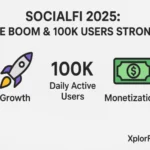LayerZero vs Wormhole: Best Cross-Chain King 2025

Yo Xplorianz, alright, let’s cut to the chase and talk about the LayerZero vs Wormhole smackdown for the title of “Cross-Chain King 2025.” This ain’t just some tech talk; it’s a heavyweight bout between two blockchain heavy-hitters, both gunning to fix that annoying “my chain can’t talk to your chain” problem. By 2025, we’re gonna see who’s really got the juice.
LayerZero vs Wormhole: Battle of the Blockchain Big Dogs
LayerZero: The Omnichain OG
LayerZero, which basically dropped in mid-2024, is all about being the omnichain protocol. Think of it like the ultimate translator for all blockchains. Its goal? To make sure every chain can chat and swap data super smoothly. The secret sauce here is Ultra-Light Nodes (ULNs), Oracles, and Relayers.
- LayerZero Endpoints: Every blockchain hooked up with LayerZero has these smart contract “endpoints.” They’re like the front door for messages flying between chains.
- Ultra-Light Nodes (ULNs): Forget those old-school “light nodes” that hog all the data. LayerZero’s ULNs are super lean and mean. They don’t need to store the whole blockchain history, making them way more efficient for cross-chain action.
- Oracles: LayerZero uses these decentralized third-party “truth-tellers” (like Chainlink and Band Protocol) to send block headers from the starting chain to the destination chain.
- Relayers: These guys are in charge of zipping transaction proofs from the source chain to the destination. The security hack is that LayerZero keeps Oracles and Relayers totally separate. As long as these two aren’t colluding, no fake messages can sneak through. It’s a “trustless” setup, meaning you don’t gotta rely on one single party.
LayerZero’s Flexes:
- Lean, Mean, and Clean Design: ULNs make it cheaper and slicker than those chunky old bridges.
- Decentralized Security: Separating Oracles and Relayers adds layers of security, cutting down on single points of failure.
- Dev-Friendly: Makes it easier for developers to build killer cross-chain apps (dApps) and tap into each chain’s unique superpowers.
- Native Asset Transfers: This is huge! LayerZero lets you move original assets 1:1 without needing weird “wrapped” versions or sketchy middlemen, making things way safer and less risky.
LayerZero’s “Uh-Ohs”:
- It’s still the new kid on the block, so its long-term security track record is still baking. Even with its slick design, cross-chain hacks are like that annoying pop-up ad that just won’t quit.

Wormhole: The Experienced Bridge Builder
Wormhole’s been in the game for a minute, a seasoned pro in the interoperability world. It’s designed to zip data and assets between different blockchains. This bad boy has already handled over a billion cross-chain messages, proving it’s got the chops. It supports a ton of networks, from EVM chains (Ethereum, Polygon) to non-EVM ones (Solana, Aptos, Sui), so it’s got serious reach.
- Guardian Network: Wormhole runs on a squad of validators called Guardians. When a dApp wants to send a message, it pings a smart contract on Wormhole’s main chain, which spits out a “log event.” Each Guardian sniffs out this event and verifies it. Once most Guardians (at least 13 out of 19) sign off, their individual signatures get mashed into one Verifiable Action Approval (VAA).
- Verifiable Action Approvals (VAAs): These are the official receipts for cross-chain events.
- Relayers: Just like LayerZero, Wormhole also has permissionless relayers. Their job is to grab those signed VAAs from the Guardian network and shoot ’em over to Wormhole’s main smart contract on the destination chain. These relayers usually get a cut from transaction fees.
Wormhole’s Flexes:
- Massive Network Support: This dude’s got over 30 blockchain networks on its roster, including all the main EVM chains, Solana, Aptos, Sui, Cosmos, and more. Talk about being everywhere!
- Message Maestro: It doesn’t just move tokens; it can send any kind of data between blockchains, letting devs build some seriously advanced cross-chain apps.
- Bulletproof Guardian Network: Its network of 19 independent validator nodes (Guardians) provides a strong security layer using a proof-of-authority (PoA) model.
- Wormhole Queries: This feature lets you directly and instantly query on-chain data across different networks via the Guardian network. Super clutch for apps that need real-time info without all the messy message passing.
Wormhole’s “Uh-Ohs”:
- Even though it’s tough, Wormhole had a pretty gnarly hack back in 2022. They’ve beefed up security big time since then, but that history is still a lingering thought.
- Having to rely on a specific number of Guardians for consensus (13 out of 19) makes some folks wonder about its decentralization compared to LayerZero’s Oracle/Relayer split.
Who’s the Cross-Chain King in 2025?
Picking the “king” of the cross-chain world in 2025 is like trying to guess which meme coin will moon next – super tricky ’cause crypto moves at light speed. But we can look at a few key factors:
1. Security:
- LayerZero: Its security design, separating Oracle and Relayer jobs, is theoretically super strong, cutting down on collusion risks. If those two stay independent, no bad messages get through.
- Wormhole: Its security leans on that decentralized Guardian network. Yeah, they had that incident, but Wormhole has poured a ton of cash into audits and security upgrades.
The Lowdown: LayerZero’s setup inherently reduces single points of failure. But Wormhole has proven it can bounce back and is constantly hardening its network. Both will be bullseyes for hackers, and how they adapt and keep things locked down will be the real test.
2. Adoption and Ecosystem:
- LayerZero: Since it launched, LayerZero has snagged a ton of projects and is constantly expanding its chain support. Its ease of use is a big draw for developers. As of July 2024, LayerZero has brought on over 70 new projects and 30+ chains, racking up a total of 300+ projects and 55,000+ on-chain contracts.
- Wormhole: This veteran has way more ecosystem partners and wider chain support, including non-EVM ones, giving it a huge market reach. Pyth Network alone is a massive contributor to Wormhole’s message volume.
The Lowdown: Wormhole’s currently got the edge in adoption and network reach. But LayerZero’s rapid growth shows it could catch up fast, especially with its focus on a buttery-smooth developer experience.
3. Transaction Volume and Liquidity:
- LayerZero: Data shows LayerZero handles around 30,000 messages daily as of July 2024, with roughly half that volume coming from asset bridging.
- Wormhole: Wormhole also sees high transaction volumes, with Solana being its busiest source chain.
The Lowdown: Transaction volume is a huge indicator of how much people are actually using these things. Both are buzzing with activity. Whoever can pull in more liquidity and handle more high-value asset transfers will have the upper hand.
4. Innovation and Development:
- LayerZero: Its “omnichain” vision and Ultra-Light Node architecture show a serious drive for pushing the envelope.
- Wormhole: Features like Wormhole Queries and support for arbitrary data transfers show it’s committed to flexibility and handling all sorts of use cases.
The Lowdown: Both protocols are constantly cooking up new stuff. The real battle will be who drops the coolest new features for developers and users, and who can stay relevant as blockchain tech keeps evolving at warp speed.
2025 Prediction: A Grudge Match!
By 2025, don’t expect one clear “king” to rule the cross-chain roost. It’ll likely be a fierce rivalry, with LayerZero and Wormhole slugging it out for market share.
- LayerZero has the potential to pull in more projects looking for a lightweight, secure, and easy-to-use cross-chain solution. Its innovative trustless architecture could make it the go-to for apps where security is absolutely non-negotiable.
- Wormhole, with its massive network reach and battle-tested track record, will probably hold its ground as the reliable bridge for assets and messages across a ton of ecosystems, especially for projects needing to connect to those non-EVM chains.
Silly Analogy: Picking the cross-chain king in 2025 is like choosing between two top-tier pizza places. LayerZero might be that hot new spot with the super-innovative dough recipe and a state-of-the-art oven that guarantees a perfectly crisp crust every time, promising a truly revolutionary pizza experience.
Wormhole, on the other hand, is the established joint that’s been serving up pies for years, with the biggest delivery radius in town, getting their delicious pizza to every neighborhood. Both will satisfy your pizza cravings, but with a slightly different vibe and reach. So, who gets your order? Are you feeling adventurous for the new-age pie, or sticking with the reliable, widely available classic?
Which one are you watching, Xplorianz? Drop your take on the most underrated pick this week in the comments!. Slide into our inbox Facebook, or tag us on X . Stay sharp, stay weird, and keep Xploring
Disclaimer:
This article is for informational and entertainment purposes only and does not constitute financial advice. Always do your own research (DYOR) before making any investment decisions, your money, your call. Crypto’s wild, so stay sharp out there!
Hot Nft Games Promising in 2025








3 month ago
[…] 14 Jul 2025 3 minute ago LayerZero vs Wormhole: Best Cross-Chain King 2025 1 day ago Coinbase and Perplexity AI 2025: Amazing Collaboration Crypto Research 3 […]